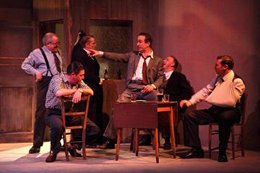There is a disturbing moment in the middle of Tom Murphy’s late play The House when the play’s ‘hero’, returned emigrant Christy Cavanagh, replies to an invitation to the local dance by “straighten[ing] up as a man might to adjust his belt” and banging the inviter’s head repeatedly against the wall. It is a moment of extraordinary violence, made all the more shocking by the pedestrian banter that both precedes and follows it. Christy’s savage outburst goes unremarked by his drinking partners, and his victim, Jimmy, is left reeling in surreal bewilderment, wondering, perhaps, whether he might have imagined Christy’s sudden attack upon him.
In the following scene at the de Burca family home – the house to which Murphy gives titular significance – the ailing Mrs de Burca and her three daughters sit around the dining table discussing pedestrian local news so as to avoid the greater issue of the imminent sale of their estate. Youngest daughter Louise sits with her back to the audience for the duration of the scene, but in the final moments she turns so that the audience can see her, revealing a black eye gifted to her by her alcoholic husband. It is another moment in which Murphy counterpoints banality with crucial dramatic revelation for maximum emotional effect.
Written in 2000 and set in the 1950s, The House is one of those rare Irish plays that is both culturally specific and timeless. It is not just the ongoing relevance of the theme of emigration that makes the play seem contemporary, but the more fundamental resonance of failed cultural ideals; for the critical importance of place to the Irish psyche – call it land, property, ‘the house’, whatever – is also what precipitated the current exodus of Ireland's youth to foreign shores.
 For this cultural excavation Murphy stays within the bounds of conventional realism, where the strictures of the form allow metaphorical resonance to grow without ever seeming forced or preachy. If there is a weakness in Annabelle Comyn’s assured production it is Paul O’Mahony’s slick, rotating anti-realist set, which, while reproducing period detail in the interior locations, is framed by a glossy canopy of photographed trees – a distracting border which forces symbolic significance where it isn’t needed. However, there is much to appreciate: Chahine Yavrohan’s lighting design, which illuminates emotional tone as well as the multiple locations and time-frames, and an array of excellent performances.
For this cultural excavation Murphy stays within the bounds of conventional realism, where the strictures of the form allow metaphorical resonance to grow without ever seeming forced or preachy. If there is a weakness in Annabelle Comyn’s assured production it is Paul O’Mahony’s slick, rotating anti-realist set, which, while reproducing period detail in the interior locations, is framed by a glossy canopy of photographed trees – a distracting border which forces symbolic significance where it isn’t needed. However, there is much to appreciate: Chahine Yavrohan’s lighting design, which illuminates emotional tone as well as the multiple locations and time-frames, and an array of excellent performances.
Murphy is the master of the unfinished sentence, and in The House he offers us myriad characters defined by halting patterns of speech, grunts, and meandering accents. They are characters whose souls are revealed not by what they say but by the sounds they make, to paraphrase JPW King in The Gigli Concert. These are the half-men produced not just by emigration, but by a stunted culture of repression. There is wisecracking Goldfish (an exuberant Karl Shiels), a patchwork of unstable selves culled from Western films; Peter (a reeling Frank Lavery), exposing a guilty conscience in drunken monologues of self-defence; bumbling bar-man Bunty (an almost unrecognisable Darragh Kelly), playing to punters and priests as best suits him; lawman Kerrigan (a scene-stealing Lorcan Cranitch) who rails against the country's hypocrisy and condemns himself in the same breath. And then, of course, there is Christy, played by Declan Conlon at the top of his game, whose wide-legged cocky posture belies the vulnerability and desperation that fuel the play’s ultimate tragedy.
And what of Murphy’s women, the de Burca girls, in whom Christy invests all hope of the future and of his redemption? They too are revealed in all their brokenness, no more so than the dying Mrs de Burca (Eleanor Methven in a performance of understated sensitivity), who still leaves an empty chair for her long-dead husband at the dining table, and who channels her own fears for the future into her daughters: confirmed spinster Marie (a stoic Cathy Belton), dramatic Suzanne (an affected Catherine Walker), and emotionally trapped Louise (the sympathetic Niamh McCann).
Like all Murphy’s work there is no happy ending in The House, but there is also none of the final optimism that lifts plays like Bailegangaire or The Gigli Concert into the transformational realm. At more than three hours long and relentlessly bleak, The House is a brave programming choice for the Abbey Theatre’s summer slot, which is often occupied by more traditional tourist-friendly fare. Those who go with it, however, will find themselves rewarded with a penetrating vision of Ireland, past and present.
Sara Keating